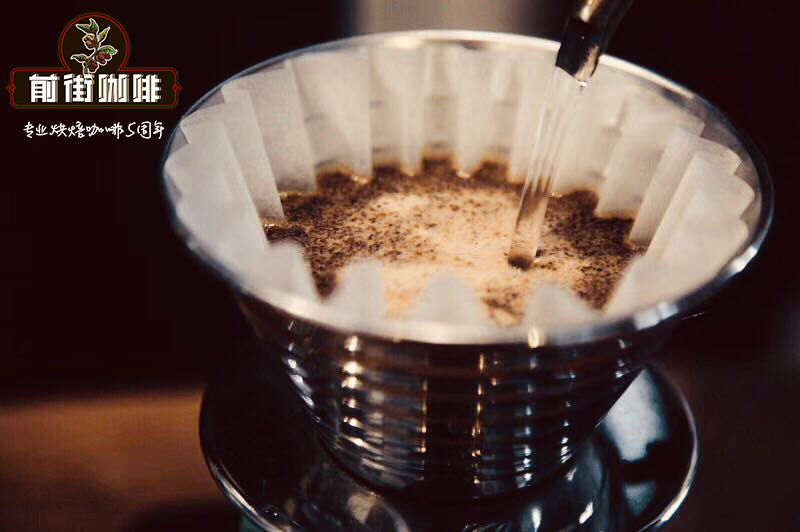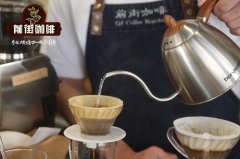What is hand-brewed coffee? what coffee beans are used to make coffee by hand? step diagram of steaming

Professional coffee knowledge exchange More coffee bean information Please pay attention to coffee workshop (Weixin Official Accounts cafe_style)
。After understanding the principle of hand-brewed coffee, we should understand that the focus of a good cup of hand-brewed coffee lies in the extraction time, that is, the time when coffee powder and hot water act. In addition to time, there are other important elements to note. As long as you master these elements well, you can greatly increase your chances of successfully making a good cup of coffee!
tool
Bean grinder:
The smaller the thickness scale number, the closer the cutter head distance, the smaller the particles.
There are manual mills and automatic mills
According to the cutter head points flat cutter and taper cutter,
Flat knife type: two-phase symmetrical blades up and down parallel, coffee beans after grinding centrifugal outward
Cone knife type: conical rotating blade, coffee bean grinding falls by gravity,
It is easier to have fine powder. The disadvantage is that coffee grounds are more complex. The advantage is that the flavor is richer.
Test coffee ground by different bean grinders in class
Hand made kettle:
All kinds of hand-made pots, and special collections...
It's mainly about choosing the capacity of the hand, too heavy to operate--
Filter bowl:
Usually tapered, with scratches on the surface to increase the time for water to flow through the coffee powder
The lower bottle opening is perforated, and the number of apertures is also different.
Some require filter paper, blanching before use, to sterilize and remove pulp flavor…
Now environmentally friendly, with washable reusable flannel, or metal through fine mesh design more than do not need filter paper
Now there are smart filter cups, put them on the filter pot before they start to leak
Less technical, known as hidden bar hands--
Filter pot:
Many styles: French press, Belgian double pot…each with different characteristics
Tool 100 points, whether it will be rushed is another matter…
Coffee making steps:
Coffee beans are ready for use: ()
Hand-brewed coffee is usually graduated with a thickness of 3.5 ()
Blanch the cup with hot water:
Waking up a pot is like boiling a cup before making tea.
Pour the coffee powder into the filter cup:
Try to make the surface of the coffee powder flat and punch a hole in the middle with a sharp object
First stage water supply:
Hot water is injected from the hole just dug (),
Water rises from the middle and radiates outward to wet the coffee powder.
until the water wets the coffee powder and the coffee powder begins to swell
Water cut:
The coffee powder continues to expand until it stops expanding and begins to dissipate downward.
Second stage water supply:
The rate of water addition is the same as the rate of dripping below.
until the bottom strainer reaches the desired extraction volume--
After brewing, remember to observe the state of coffee powder
Hand-brewed coffee adjustable parameters and principles:
The above step () indicates that the parameters that can be adjusted according to different beans--
After many trials, the most appropriate value is taken. Experience value is very important!
Take shallow cultivation beans for example, low oil content, poor water absorption,
In order to make the extraction efficiency better, usually the grinding will be finer, and the water temperature should be higher!
Ratio of powder to water: adjust the ratio according to personal taste,
Coffee beans (g): coffee (c. c) ratio is usually 1:15,
So a cup of coffee is about 16 grams of coffee beans, hand brewed 240 ml coffee
Also serve iced coffee ratio: double the strength, shake evenly with ice,
Maintain coffee beans, halve hot water, and fill the rest with ice cubes.
But at this time, the hand speed should be slowed down, that is, the water column should be reduced, so as to maintain the extraction time.
Double the coffee beans, maintain the hot water, divide into two cups, fill both cups with ice cubes
Shake out dense and delicate foam, is the essence of iced coffee to drink,
Coffee coats the air and releases its aroma.
But after a long time, it will disappear again. Just shake it again.(It is very similar to the principle of milk foam.)
Powder fineness: surface area affects extraction rate
Coarse: small surface area, less extraction
Fine: large surface area, high extraction
Water temperature: high temperature, more complete extraction, low temperature, less extraction
Too high temperature: easy to over-extract, taste may also be more complex (complex and rich are two sides of one)
Foaming during brewing
During brewing, coffee powder is extracted too fast, leaving a line mark when flooded.
After brewing, the powder appears hot and melted brownie like...
Temperature too low: incomplete extraction, there will be grass flavor
When brewing, the powder will not swell
When supplying water to the second stage, it is easy to collapse because the front part does not absorb water completely.
Permeability of water:
Water will seep between the coffee grounds, so only central water is needed.
Draw a circle to show off your skills? No clear function!
Add water too fast: the water will marinate and eventually leave a trail on the filter cup
Water too slow: coffee powder does not fully combine with water swelling, coffee powder after extraction presents collapse condition
Posture and mood:
Making coffee by hand is a pleasure,
You have to relax your posture and mood before you can make good coffee_
So there's coffee divination, see what kind of coffee you make and what kind of coffee you make, and you know your body and mind.
Good extraction time can improve the chances of successful brewing of good coffee.
Coffee Powder Particle Uniformity
Fine coffee powder extraction speed is fast, coarse coffee powder extraction speed is slow, we can adjust the size of coffee powder according to the flavor of coffee beans and their own brewing habits. However, whether large or small, if the powder particles are uneven, it is possible that when the fine coffee powder has begun to release bitter molecules, the coarse coffee powder has not been completely extracted and cannot present the most original unique flavor of coffee beans.
Coffee powder particle size
The finer the coffee powder, the longer it takes hot water to flow through it.
Filter paper thickness
The thicker the filter paper, the slower the flow rate of the extract, and the longer the hot water reacts with the coffee powder.
Water injection rate and mode
Water injection uniform, stable, in order to make coffee powder extraction speed consistent. In addition, the height of the water injection will also affect the water temperature, it is recommended to close to the filter cup as much as possible, in order to repeatedly circle the way water injection.
water temperature
The higher the water temperature, the faster the extraction speed. It is generally recommended that coffee beans be brewed at 80 - 90 degrees for deep roasts and 90 - 97 degrees for light and medium roasts.
The next time you brew coffee, you may wish to pay attention to the above elements, which can help the stability of coffee taste and ensure the taste of coffee!
Important Notice :
前街咖啡 FrontStreet Coffee has moved to new addredd:
FrontStreet Coffee Address: 315,Donghua East Road,GuangZhou
Tel:020 38364473
- Prev

Wang ce: brewing and tasting of hand-brewed Coffee the World Champion's course on hand-brewing Coffee
Professional coffee knowledge exchange more coffee bean information please follow the coffee workshop (Wechat official account cafe_style) for baristas, especially competitors like me, coffee needs to be analyzed, understood, and reorganized. The three states of coffee, raw beans, cooked beans and liquid, are the topics we will reveal in these articles. This article will use the hand coffee that I am good at.
- Next

Top Ten recommendations of Coffee utensils-which brand of coffee maker is recommended by hand coffee maker
Professional coffee knowledge exchange more coffee bean information please follow the coffee workshop (Wechat official account cafe_style) coffee story the temperature of a cup of coffee top ten recommendations, hand coffee coffee equipment recommended temperature is everything that determines the taste of coffee, immersed in the comfortable spring afternoon sun, enjoying afternoon tea, thinking of all the temperature brought to me. I like Fei.
Related
- Beginners will see the "Coffee pull flower" guide!
- What is the difference between ice blog purified milk and ordinary milk coffee?
- Why is the Philippines the largest producer of crops in Liberia?
- For coffee extraction, should the fine powder be retained?
- How does extracted espresso fill pressed powder? How much strength does it take to press the powder?
- How to make jasmine cold extract coffee? Is the jasmine + latte good?
- Will this little toy really make the coffee taste better? How does Lily Drip affect coffee extraction?
- Will the action of slapping the filter cup also affect coffee extraction?
- What's the difference between powder-to-water ratio and powder-to-liquid ratio?
- What is the Ethiopian local species? What does it have to do with Heirloom native species?

